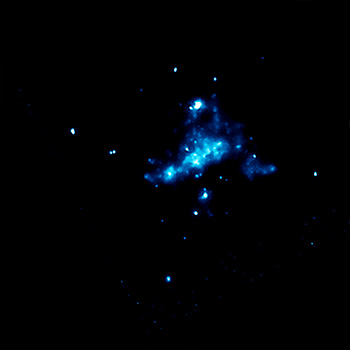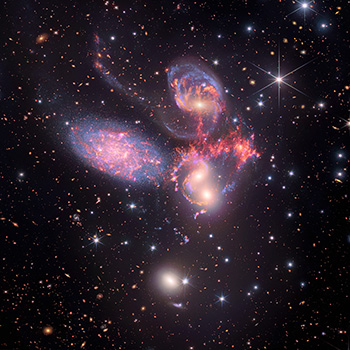
Stephan's Quintet Sonification
In Stephan’s Quintet, four galaxies move around each other, held together by gravity, while a fifth galaxy sits in the frame but is actually at a much different distance. The pitch in a sonification of Chandra and James Webb data changes in relationship to the brightness in different ways. The background galaxies and foreground stars in the visual images Webb detects are mapped to different notes on a synthetic glass marimba. Meanwhile, stars with diffraction spikes are played as crash cymbals. The galaxies of Stephan’s Quintet themselves are heard as smoothly changing frequencies as the scan passes over them. The X-rays from Chandra, which reveal a shock wave that has superheated gas to tens of millions of degrees, are represented by a synthetic string sound.
Access more information & file formats on this sonification
The Chandra sonifications were led by the Chandra X-ray Center (CXC), with input from NASA's Universe of Learning. The sustained collaboration was driven by visualization scientist Dr. Kimberly Arcand (CXC), astrophysicist Dr. Matt Russo and musician Andrew Santaguida (both of the SYSTEM Sounds project). For other sonifications, please see their linked pages.
cxcpub@cfa.harvard.edu
617-496-7941
60 Garden Street,
Cambridge, MA 02138 USA
Art Direction/Design: Kristin DiVona
Web Developers: Khajag Mgrdichian
& Kelly T.S. Williamson
Chandra X-ray Center, Operated for NASA by the Smithsonian Astrophysical Observatory. This site was developed with funding from NASA under contract NAS8-03060 | Privacy | Accessibility
Additional support from NASA's Universe of Learning (UoL). UoL materials are based upon work supported by NASA under award number NNX16AC65A to the Space
Telescope Science Institute, working in partnership with Caltech/IPAC, Jet Propulsion Laboratory, and Smithsonian Astrophysical Observatory.



